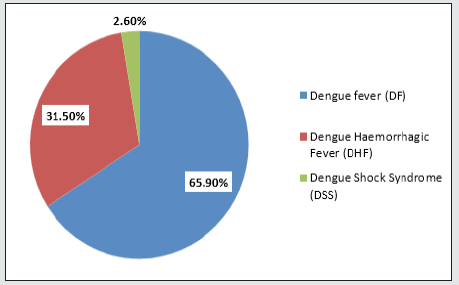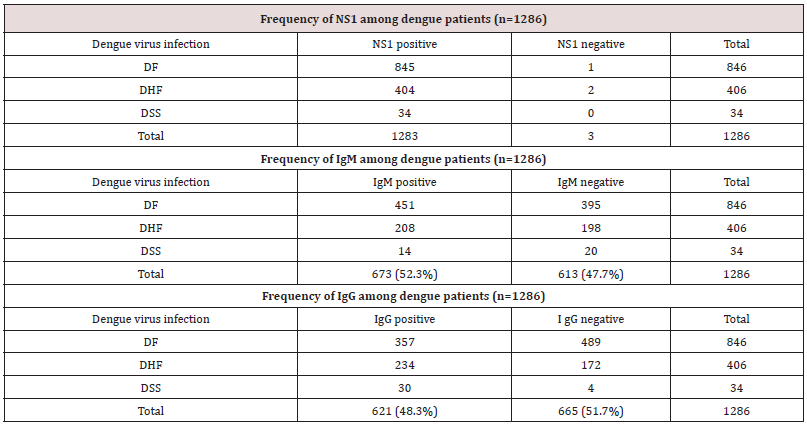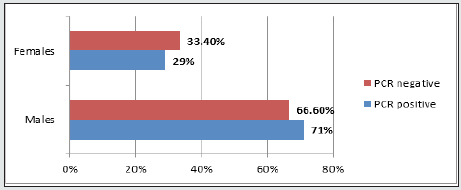
Lupine Publishers Group
Lupine Publishers
Menu
ISSN: 2637-6679
Research Article(ISSN: 2637-6679) 
Heterogeneity Of Dengue Virus Serotypes Among Dengue Patients of Rawalpindi & Islamabad During Dengue Epidemic 2016 Volume 6 - Issue 4
Haroon Rahim1, Rizwana Shahid2*, Shazia Zeb3
- 1Medical Officer, Tehsil Head Quarter Hospital, Gujar Khan
- 2Assistant Professor Community Medicine, Rawalpindi Medical University, Rawalpindi
- 3Medical Superintendent, Holy Family Hospital, Rawalpindi
Received:July 01, 2021 Published: July 14, 2021
Corresponding author:Rizwana Shahid, Assistant Professor Community Medicine, Rawalpindi Medical University, Rawalpindi
DOI: 10.32474/RRHOAJ.2021.06.000242
Abstract
Objectives: To determine the frequency of various dengue virus serotypes circulating among dengue patients residing in Rawalpindi and Islamabad during dengue epidemic 2016.
Methods: A cross-sectional descriptive study was carried out among dengue patients admitted in Holy Family Hospital that was basically the teaching hospital affiliated with Rawalpindi Medical University. The data was collected during dengue epidemic from July - September 2016 pertinent to demographics, various bleeding manifestations, dengue virus infections and hospital stay through consecutive sampling. Independent sample t-test was applied to determine the gender and residence wise duration of fever. However, difference in mean age of dengue patients with varied clinical manifestations was ascertained by ANOVA. The data was analyzed by means of SPSS version 25.0 and Microsoft Excel 2010.
Results: Out of 1286 dengue patients enrolled in research, most (69.6%) were males. Mean age of study subjects was 35.7± 1.57 years and 70% were residents of Islamabad. About 65.9% had Dengue Fever (DF) while 31.5% and 2.6% were diagnosed with Dengue Haemorrhagic Fever (DHF) and Dengue Shock Syndrome (DSS) respectively. Mean duration of fever among our patients was 2.1 ± 0.73 days. However, residence wise and gender wise difference in mean duration of fever was found to be statistically significant with P<0.02 and P<0.01 respectively. DEN-2 and DEN-3 maximally prevailed. However, IgM and IgG were positive among 52.3% and 48.3% dengue patients respectively.
Conclusion: Dengue virus is affecting the population of Pakistan continuously. All four types of dengue virus prevailed in our population including mixed serotypes. DEN-2 and DEN-3 were determined to be the dominant circulating serotypes with higher propensity among males.
KeywordsEpidemic; Dengue Fever; Dengue Hemorrhagic Fever; Dengue Shock Syndrome; Dengue Virus Serotypes.
Introduction
Dengue fever is prevailing as a leading public health disease with clinical manifestations resembling to those of other febrile ailments[1]. Its peak incidence in Pakistan is primarily acknowledged after monsoon[2]. The determination of diverse dengue viral infections is quite ponderous due to complex clinic-pathological presentations of all fours viral serotypes. Moreover, infection by one serotype is not known to provide long-term protection against other serotypes [3]. Dengue virus infections prevail in urban and semi-urban regions of the world. Approximately half of the world’s inhabitants are reported to be at risk of this infection with registration of about 100-400 million dengue cases annually[4]. Occurrence of dengue epidemics in Pakistan is primarily attributed to overcrowding, poor environmental sanitation and inadequate vaccination[5]. Raised mortality and morbidity in Pakistan and other Asian countries are accounted due to dengue virus infections[6]. Although Dengue Hemorrhagic Fever (DHF) and Dengue Shock Syndrome (DSS) together constitutes only 5% of dengue virus infections, but incidence can be higher among those who were formerly infected by other dengue virus serotypes[7].
Numerous epidemics of dengue have occurred previously with reporting of thousands of fatalities[8]. People with secondary dengue infection cause by a serotype differing from that of reported in primary infection depicted grave clinical manifestations[9]. One infected individual not only becomes the basis for virus multiplication but also the source of infection to others in the community[10]. Efficient and timely management of dengue cases in all provinces of Pakistan was ascertained through provision of all diagnostic and managerial amenities[11]. However, determination of dengue virus serotypes among human beings is necessitated for better diagnosis and implicit management of dengue cases[12]. The current study is therefore intended to determine the serotypes of dengue virus circulating among dengue patients residing in twin cities during dengue epidemic 2016. This research would really prove beneficial to our policy makers in limiting the spread of dengue by strategizing an appropriate action plan and hence would contribute in lessening the dengue associated mortality and morbidity.
Subjects & Methods
A cross-sectional descriptive research was done among dengue patients admitted in Holy Family Hospital during dengue epidemic from July - September 2016. This hospital was affiliated with Rawalpindi Medical University as a teaching hospital. As this was a thesis based research, so permission was taken from Ethical Committee of Sarhad University Peshawar as well as Medical Superintendent of Holy Family Hospital for data collection in a proper manner. The data was gathered pertinent to demographics, diverse bleeding manifestations, dengue virus infections and length of hospital stay through consecutive sampling. Independent sample t-test was applied to determine the gender and residence wise duration of fever. However, difference in mean age of dengue patients with varied clinical syndrome manifestations was ascertained by ANOVA. The data was analyzed by means of SPSS version 25.0 and Microsoft Excel 2010.
Results
Of the total 1286 dengue patients admitted in Holy Family Hospital during dengue epidemic 2016, 895 (69.6%) were males and 391 (30.4%) were females. Mean age of the dengue patients was 35.7± 1.57 years. Most 899 (69.9%) of dengue patients were resident of Islamabad. Majority of them was suffering from dengue fever as depicted below in Figure 1. Mean duration of fever among dengue patients was found to be 2.1 ± 0.73 days. Duration of fever with respect to gender and residence was computed to be statistically significant on application of independent sample t-test as shown below in Table 1. Statistically insignificant difference in age of the patients diagnosed with dengue fever, DHF and DSS was determined on application of ANOVA as revealed in Table 2. Table 3,4 Blood serum of about 369 (28.7%) study subjects did not reveal any of the dengue serotypes while 917 patients were determined to have varied dengue serotypes as shown below in Table 5. of the total 1286 dengue patients, about 1281 were recovered and discharged while 05 patients were expired.
*Independent samplt t-test.
*Anova.
Discussion
Dengue is one of the commonest vector borne infections that afflicts millions of the people across the globe particularly those residing in Asia[13]. Rapid propagation of aedes mosquito is primarily associated with population explosion with resultant rapid urbanization, water stagnation and blockade of sewers in Pakistan. In addition, domestication of diverse strains of aedes worldwide is attributed to massive travel and trade[14]. Pakistan is known to have all the attributes inducing the proliferation of mosquitoes that should essentially be arrested to minimize the ensuing fatalities[15]. The mean age of dengue patients enrolled in current study was found to be 35.7± 1.57 years. However, difference in mean age of our patients suffering from Dengue Fever (DF), Dengue Hemorrhagic Fever (DHF) and Dengue Shock Syndrome (DSS) was determined to be statistically significant (P < 0.07) as illustrated in Table 2. Mean duration of dengue fever among our study subjects was 2.1 ± 0.73 days. In addition gender wise and residence wise diversities in mean duration of fever among our dengue patients were verified to be statistically significant with P value of <0.02 and 0.01 respectively (Table 1). Likewise a study done on dengue patients from the community of Lahore as well as from two tertiary care hospitals revealed mean age of the patients around 36 years[16]. On the other hand mean age of the dengue patients reported during Bangkok epidemic 1997-98 was 26.9 ± 11.9 years. Moreover, mean duration of dengue fever was determined to be 5.2 ± 3.2 days[17]. The variations in mean age of dengue patients as well as duration of fever might be due to racial or ethnic differences that should meticulously be studied to discover an underlying logic. About 65.9% of our dengue patients were suffering from dengue fever followed by 31.5% and 2.6% diagnosed with DHF and DSS respectively. Contrary to our results, a cross-sectional study carried out among patients manifesting acute febrile illness in Karachi revealed that only 31.11% study participants were suffering from dengue and about 7.7% were diagnosed as cases of malaria. However, rest of the 61.11% was labeled as dengue probable[18]. Pyrexial manifestations may originate due to infective, inflammatory or neoplastic cause[19] that should systematically be investigated to avoid grave health consequences. Likewise our results, a study done among dengue patients by Changal KH et al. illustrated the raised proportion of DHF (38.2%) as compared to DSS (2.6%)[20]. WHO classification and case definitions pertinent to DF, DHF and DSS should adequately be addressed to ensure appropriate case management.
Dengue serotypes were undetectable among serological samples of about 28.7% of our dengue patients. However, serological testing of rest of the 917 (71.3%) dengue cases reflected the presence of DEN-2 among majority (49.2%) followed by DEN- 3 among 42.5%. however 6.01% patients had DEN-2 & 3 in their sera. A research done on dengue cases during dengue epidemic 2017 Khyber Pakhtunkhawa province of Pakistan revealed the presence of DEN-2 among most (38%) patients followed by DEN- 3 (37%), DEN-4 (11%) and 8% with mixed serotypes. Only 5% subjects had DEN-1[21]. An Indian research showed the presence of DEN-2 among most (60.5%) of the dengue cases20. Likewise serological testing done among populates of Indonesia disclosed the presence of DEN-2 and DEN-4 only[22]. A retrospective study done by Suppiah J et al during 2018 revealed predominance of DEN-1. However both DEN-1 and DEN-3 were associated with mild clinical presentations while DEN-2 was linked with fatal health outcomes[23]. So the presence of dengue virus serotypes seems to diversify in various global regions. However its relationship with severity of disease should conscientiously be investigated through prospective researches for methodical verification. World Health Organization has laid emphasis on observing stringent precautionary measures for protection against dengue specifically amidst COVID pandemic in order to lessen the burden on existing healthcare facilities[24]. Rapid emergence of infectious diseases, their diverse variants and swift dissemination worldwide is quite alarming. Practicing preventive measures is the need of the hour to abstain from devastating health consequences.
Conclusion & Recommendations
DEN-2 and DEN-3 were found to be the prevalent serotypes particularly among males. Surroundings of Rawalpindi/Islamabad are less developed and lack basic medical facilities and lack of awareness, poor waste management system and education. The eradication of dengue vector is difficult due to improper implementation of preventive measures. Stringent efforts of our policy makers are required to curb this havoc by adequate environmental management and integrated vector control. Dengue Expert Advisory Group Guidelines should also be consistently observed.
References
- Farnandez E, Smieja M, Walter SD, Loeb M (2016) A predictive model to differentiate dengue from other febrile illness. BMC Infectious Diseases 16: pp.694.
- Jahan F (2011) Dengue Fever (DF) in Pakistan. Asia Pac Fam Med 10(1): p.1.
- Khanani MR, Arif A, Shaikh R (2011) Dengue in Pakistan: Journey from a disease free to a hyper endemic nation. JDUHS 5(3): 81-84.
- World Health Organization (2020) Dengue and severe dengue.
- Keating J (2001) An investigation into the cyclical incidence of dengue fever. Social Sci Med 53: 1587-1597.
- Zubair M, Ashraf M, Ahsan A, Nazir N, Hanif H, et al.(2016) Dengue viral infections in Pakistan and other Asian countries: A comprehensive review. J Pak Med Assoc 66(7): 884-888.
- Pooja C, Amrita Y, Viney C (2014) Clinical implications and treatment of dengue. Asian Pacific J Trop Med 7(3): 169-78.
- Shahid M, Amin I, Afzal S (2017) Prevalence and molecular detection of dengue virus in 2013 outbreak in KPK and Punjab, Pakistan. Pakistan J Zool 49: 1119-1122.
- Garg A, Garg AJ, Rao YK, Upadhyay GC, Sakhuja S (2011) Prevalence of dengue among clinically suspected febrile episodes at a Teaching Hospital in North India. J Infect Dis Immunol 3: 85-89.
- WHO/TDR (2009) Dengue: guidelines for diagnosis, treatment, prevention, and control. Special Programme for Research and Training in Tropical Diseases pp.147.
- WHO (2019) Dengue fever -Pakistan.
- Khan N, Danish L, Khan N, Shah M, Ismail M, Ali I (2020) Prevalence of dengue virus serotypes in 2017 outbreak in Peshawar, KP, Pakistan. J Clin Lab Anal 34: e23371.
- Wilder-Smith A, Ooi E-E, Horstick O (2019) Wills B Dengue. Lancet 393: 350-363.
- Fatima Z, Afzal S, Idrees M, S Rafique, M Akram, B Khubaib, et al. (2013) Change in demographic pattern of dengue virus infection: evidence from 2011 dengue outbreak in Punjab, Pakistan. Public Health 127: 875-877.
- Fatima Z (2019) Dengue infection in Pakistan: not an isolated problem. Lancet Infect Dis 2019; 19(12): 1287-1288.
- Saqib MAN, Rafique I, Bashir S, Salam AA (2014) A retrospective analysis of dengue fever case management and frequency of co-morbidities associated with deaths. BMC Research Notes 7: 205.
- Tantawichien T (2012) Dengue fever and dengue haemorrhagic fever in adolescents and adults. Paediatr Int Child Health 32(s1): 22-27.
- Hasan SR, Riaz M, Jafri FA (2013) Characteristics and outcome of dengue infection; Clinical perspective from a secondary care hospital of Karachi. Pak J Med Sci 29(1): 115-118.
- Fernandez C, Beeching NJ (2018) Pyrexia of unknown origin. Clin Med (Lond) 18(2): 170-174.
- Changal KH, Raina AH, Raina A, Raina M, Bashir R, Latief M, et al. (2016) Differentiating secondary from primary dengue using IgG to IgM ratio in early dengue: An observational hospital based clinic-serological study from North India. BMC Infectious Diseases 16: 715.
- Khan Nu, Danish L, Khan HU, Shah M, Ismail M, Ali I, et al. (2020) Presence of dengue virus serotypes in the 2017 outbreak in Peshawar, KP, Pakistan. JCLA 34(9): e23371.
- Taslim M, Arsunan AA, Ishak H, Nasir S, Usman AN (2018) Diversity of dengue virus serotypes in endemic region of South Sulawesi Province. J Trop Med 1: 1-4.
- Suppiah J, Ching S, Amin Nordin S, Mat Nor L, Ahmad Najimudin N, et al. (2018) Clinical manifestations of dengue in relation to dengue serotype and genotype in Malaysia: A retrospective observational study. PLos Negl Trop Dis 12(9): e0006817.
- World Health Organization (2021) Dengue and severe Dengue.

Top Editors
-

Mark E Smith
Bio chemistry
University of Texas Medical Branch, USA -

Lawrence A Presley
Department of Criminal Justice
Liberty University, USA -

Thomas W Miller
Department of Psychiatry
University of Kentucky, USA -

Gjumrakch Aliev
Department of Medicine
Gally International Biomedical Research & Consulting LLC, USA -

Christopher Bryant
Department of Urbanisation and Agricultural
Montreal university, USA -

Robert William Frare
Oral & Maxillofacial Pathology
New York University, USA -

Rudolph Modesto Navari
Gastroenterology and Hepatology
University of Alabama, UK -

Andrew Hague
Department of Medicine
Universities of Bradford, UK -

George Gregory Buttigieg
Maltese College of Obstetrics and Gynaecology, Europe -

Chen-Hsiung Yeh
Oncology
Circulogene Theranostics, England -
.png)
Emilio Bucio-Carrillo
Radiation Chemistry
National University of Mexico, USA -
.jpg)
Casey J Grenier
Analytical Chemistry
Wentworth Institute of Technology, USA -
Hany Atalah
Minimally Invasive Surgery
Mercer University school of Medicine, USA -

Abu-Hussein Muhamad
Pediatric Dentistry
University of Athens , Greece

The annual scholar awards from Lupine Publishers honor a selected number Read More...

.png)









